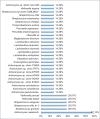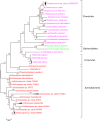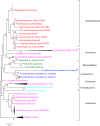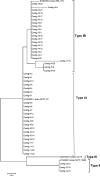Isolation of Propionibacterium acnes among the microbiota of primary endodontic infections with and without intraoral communication
- PMID: 26856712
- PMCID: PMC5069318
- DOI: 10.1007/s00784-016-1739-x
Isolation of Propionibacterium acnes among the microbiota of primary endodontic infections with and without intraoral communication
Abstract
Objectives: The presence of opportunistic pathogens such as Propionibacterium acnes (P. acnes) may contribute to the endodontic pathology. The presence of P. acnes may be influenced by different endodontic conditions. The aims of the study were firstly, to identify P. acnes within the whole cultivable microbiota of primary endodontic infections, to investigate which P. acnes phylotypes predominate in such infections and secondly to determine if the presence of an "open" communication (e.g. a sinus) can be associated with the isolation of P. acnes from the root canal.
Material and methods: The predominant cultivable microbiota of 15 primary endodontic lesions (7 without communication with the oral environment and 8 with an open communication) were identified using partial 16S ribosomal RNA (rRNA) gene sequence analysis. The identification of the organism was determined by interrogating the Human Oral Microbiome Database. The P. acnes isolates were typed on the basis of the recA gene sequence comparison. A neighbor-joining tree was constructed using MEGA 4.1 with the inclusion of known recA sequences.
Results: There was no difference in the number of species identified from lesions without communication (5.86 ± 3.7) and those with communication (5.37 ± 3.6) (P > 0.05). PCR-based 16S rRNA gene sequencing revealed P. acnes as the most prevalent isolate recovered from lesions with communication. recA gene sequencing revealed two phylogenetic lineages present in lesion with communication, with mainly type I (further split into type IA and type IB) and type II.
Conclusions: The presence of P. acnes as opportunistic pathogens has been confirmed and may sustain the traits observed in specific clinical presentations.
Clinical relevance: Clinical management of open lesions may require further disinfection to eliminate opportunistic bacteria.
Keywords: Endodontic disease; Fistula; Nosocomial infection; P. acnes.
Conflict of interest statement
Compliance with ethical standards The project was approved by the local ethics committee (South London REC: 05/Q0705/051). Conflict of interest The authors declare that they have no competing interests. Informed consent The patient had verbal and written information about the purpose of study and they gave their written informed consent prior to their inclusion.
Figures





References
-
- McDowell A, Gao A, Barnard E, Fink C, Murray PI, Dowson CG, Nagy I, Lambert PA, Patrick S. A novel multilocus sequence typing scheme for the opportunistic pathogen Propionibacterium acnes and characterization of type I cell surface-associated antigens. Microbiology. 2011;157(Pt 7):1990–2003. doi: 10.1099/mic.0.049676-0. - DOI - PubMed
-
- Eady EA, Ingham E. Propionibacterim acnes—friend or foe? Rev Med Microbiol. 1994;5:163–173. doi: 10.1097/00013542-199407000-00003. - DOI
MeSH terms
LinkOut - more resources
Full Text Sources
Other Literature Sources

